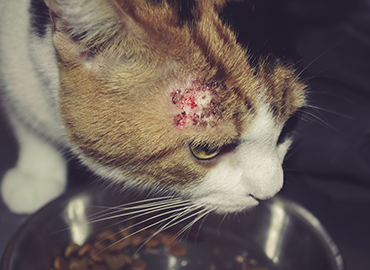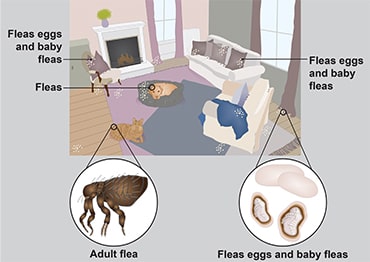Flea Allergic Dermatitis in cats
Overview
- If your cat is allergic to fleas, they will develop intense itching and a rash every time they are bitten.
- A rash, hair loss, constant scratching, and skin infections are all common symptoms of a flea allergy.
- Flea allergic dermatitis can develop at any point throughout your cat’s life.
- Fortunately, with treatment cats with flea allergic dermatitis often live a normal, happy life.
- Contact your vet if you think your cat might have flea allergy.
What is flea allergic dermatitis?
Flea-allergic dermatitis (FAD) is an allergy to flea saliva. Cat’s with FAD experience intense itching and a rash each time they are bitten by a flea. The rash is typically small and bumpy rash (making it feel as though there is grit under the fur), and tends to develop around their head, neck, tummy, and back legs. In an attempt to sooth their itch, cat’s with FAD often excessively scratch, lick, and bite their skin which can lead to red, raw, infected patches, and in severe cases, a condition called ‘eosinophilic dermatitis’. Left untreated, FAD has the potential to severely affect your cat’s quality of life, but fortunately, in most cases it’s a simple condition to manage.

Symptoms
- Itchy skin
- Over grooming
- Alopecia (fur loss)
- A small bumpy rash (often around the head, neck, lower back, tummy and back legs)
- Eosinophilic dermatitis
- Flea dirt (black specks) or fleas - you may not see fleas, especially if your cat is overgrooming and removing them.
Treatment
Flea treatment
Cats with flea allergic dermatitis need very strict flea control. However, many flea treatments only kill fleas after they have bitten, which means that your cat may still get bitten and have reactions from time to time. This is why in most cases of FAD, it’s also important to use a flea-repellent to stop your cat getting bitten altogether. It’s really important to use products recommended by your vet, to treat all your pets in your household (not just the pet with a flea allergy), and also your home (with a household flea spray). Remember, only 5% of a flea infestation lives on your pet, the rest live in your home.
Household cleaning
Regularly vacuuming your home will help remove fleas and their eggs from carpets and soft furnishings.
Medication
If your cat has a flare-up of symptoms, it’s likely that your vet will prescribe some of the following treatments:
- Steroids - to reduce the allergic reaction, itch and inflammation. Steroids can be given as tablets, an injection, or as a cream to rub on the skin.
- Antibiotics - if your cat has a skin infection they may be given antibiotics. Always follow the instructions carefully and finish the course. It’s important to be aware that antibiotics aren’t always needed and will only be prescribed if your vet thinks they are appropriate.
Preventing overgrooming
At the start of a flare-up, to prevent your cat causing further damage to their skin, it may be necessary to use a buster collar, body suit or dressing. However, this should only be until your cat’s medication has started working (which usually takes 12-48 hours), and never as a long-term solution (it may stop your cat scratching but it won’t stop them feeling itchy and uncomfortable).

95% of a flea infestation is in the home, only 5% is on your pets.
Outlook and Ongoing Care
Fortunately, with treatment your cat is likely to live a normal, happy life. Their treatment for FAD will need to be ongoing, but this is likely to be as simple as strict flea control and keeping an eye out for flare-ups. If your cat has a flare-up, contact your vet straight away, before it has a chance to get any worse.
Cost
Initially, treating a flea allergy can be expensive, especially if your cat’s symptoms are severe and they need regular check-ups. However, in the long term, once your cat’s condition is under control, their treatment is likely to be relatively inexpensive. In some cases, the only cost is regular flea treatment.
It’s always important to speak to your vet openly about your finances, the cost of treatment, as well as what you think is right for your cat. There is often more than one treatment option, so if one doesn’t work for you and your cat then your vet may be able to offer another.
Consider taking out Cat Insurance as soon as you bring your cat home, before any signs of illness start. This will give you peace of mind that you have some financial support if they ever become unwell.
Published: April 2021
Did you find this page useful?
Tell us more
Please note, our vets and nurses are unable to respond to questions via this form. If you are concerned about your pet’s health, please contact your vet directly.
Thank you for your feedback
Want to hear more about PDSA and get pet care tips from our vet experts?
Sign up to our e-newsletter
Written by vets and vet nurses. This advice is for UK pets only. Illustrations by Samantha Elmhurst.

